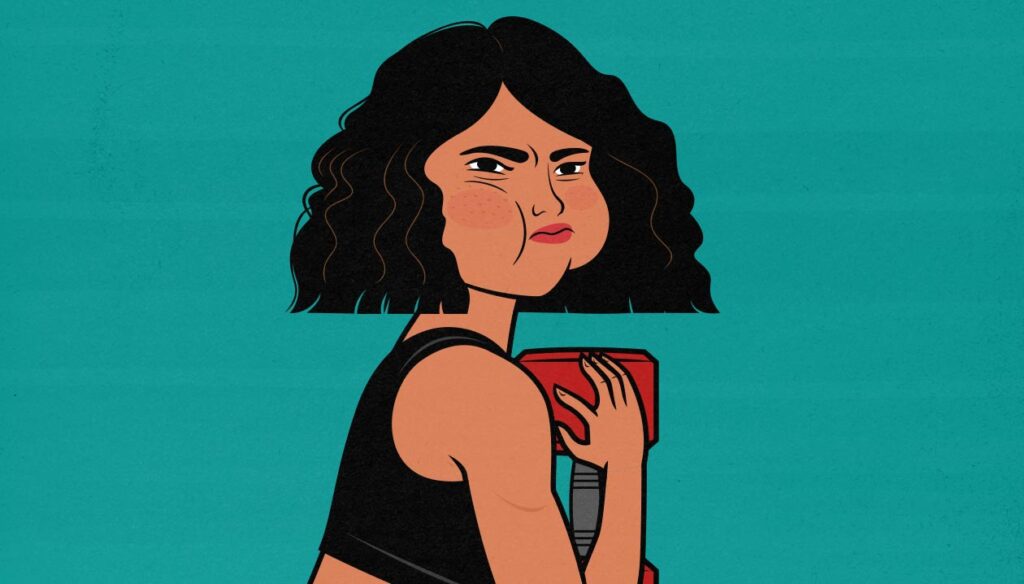
Beginner Muscle-Building Workout Plan for Women (Home or Gym)
This is a 3-day full-body muscle-building routine for women just starting out or just getting back into lifting weights. You can do it in your living room with adjustable dumbbells, in your basement with a barbell home gym, or with a full gym membership.
This is a beginner routine, but that doesn’t mean we aren’t serious about it. Marco has experience training some of the best female athletes in the world, including women on our Olympic rugby team.
The workouts are designed to stimulate muscle growth, which makes them perfect for gaining weight and building muscle, but you could take this one of three ways:
- Bulking: If you’re gaining weight, this workout program will help keep your gains lean.
- Cutting: If you’re losing weight, this workout program will maintain your muscle mass, allowing you to burn pure fat. You may even gain a small amount of muscle.
- Recomping: If you’re skinny fat, you can build muscle while burning fat. This workout program will stimulate muscle growth, and your body will pull the energy it needs from your fat stores.
I’ll explain the workout routine, and Marco will teach you the exercises with tutorial videos.
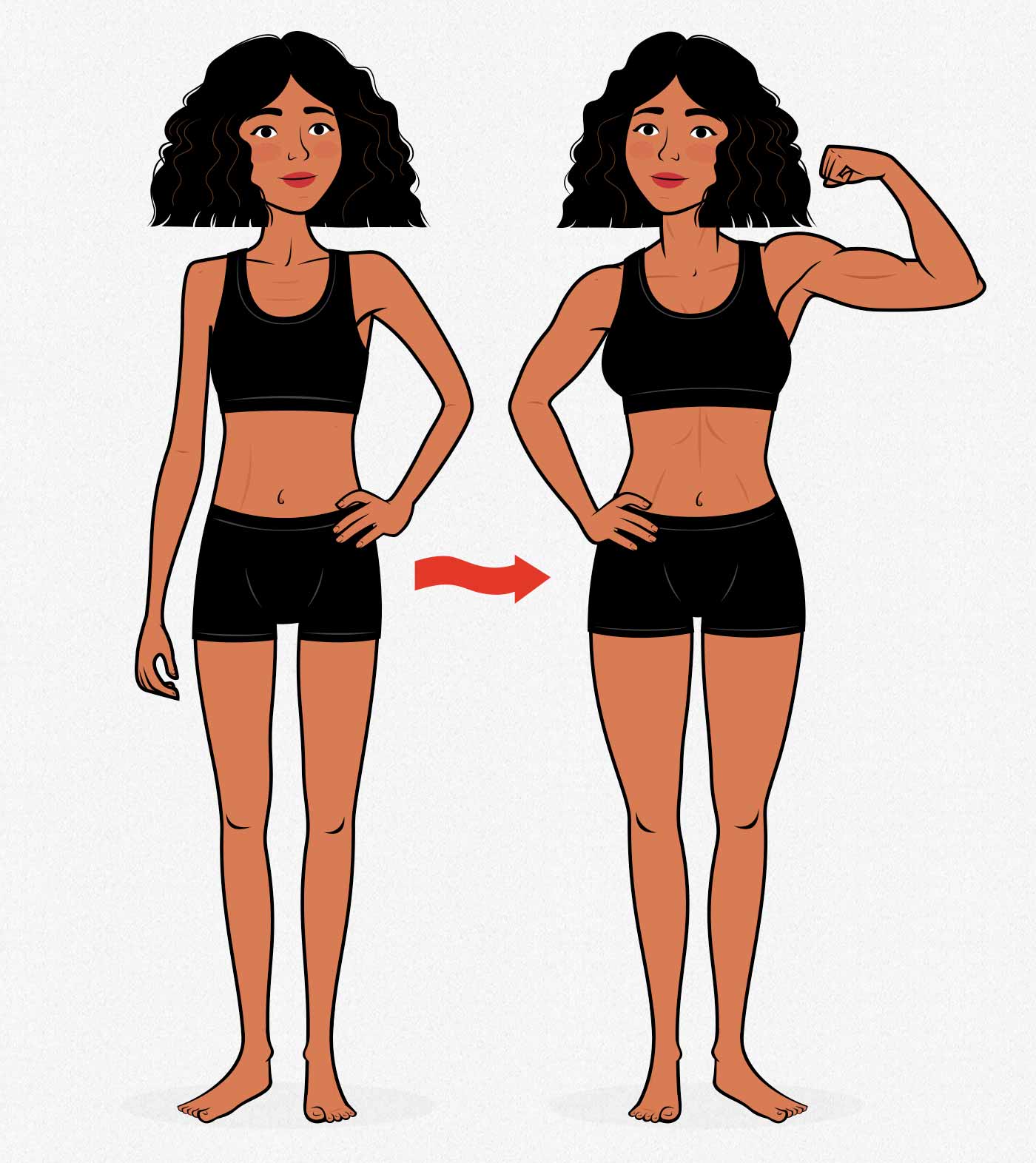
An Introduction to Hypertrophy Training
Hypertrophy training means “growth training.” It’s the type of exercise you do to build bigger, stronger muscles. It’s perfect if you’re thin and trying to gain weight, but it’s important for everyone.
It’s the default type of strength training recommended by most health experts and health organizations. When you hear the World Health Organization telling everyone to lift weights at least twice per week, they’re talking about hypertrophy training. They’re recommending a workout routine exactly like this one.
It’s also the best type of exercise for improving your appearance. Cardio is better for burning fat and shrinking your waist, whereas hypertrophy training is better for building muscle and developing a stronger, curvier, and more athletic physique.
A good hypertrophy training program looks like this:
- Weight Training: It’s possible to build muscle with bodyweight exercises, resistance bands, or other gadgets, but you’ll do far better with some combination of weights, exercise machines, and cables. If you want to do it at home, I recommend getting a pair of adjustable dumbbells. You can follow this workout plan or even our full transformation program with just dumbbells.
- Compound Exercises: Most of your muscle growth will come from getting gradually stronger at the big exercises, such as: squats, Romanian deadlifts, push-ups, and rows. Hip thrusts are good if you want extra glute stimulation. You can do those exercises with a barbell or dumbbells. What matters is that you push hard now and lift even more weight next time.
- Isolation Exercises: Most of your growth will come from compound exercises, and some of your muscles (like your glutes) will get fully stimulated by those compound exercises. But you can also target specific muscles with isolation exercises, which can sometimes help them grow even faster.
- Proper Workout Programming: This workout program will have you doing 5–30 repetitions per set, taking those sets close to failure, resting 1–3 minutes between sets, doing 3–8 sets per muscle per workout, and training each muscle 2–3 times per week. That’s absolutely perfect for building muscle.
- Progressive Overload: Write down how much weight you lift, how many reps you get, and then try to do better next time. Always try to outlift yourself. If you can do that, you can be confident you’re building muscle and gaining strength. I explain all the nuances here.
This is a 3-day workout routine, but you’re free to take it at a slower pace, doing two workouts per week. You won’t gain muscle and strength quite as quickly, but you’ll still make great progress, and that’s still enough to reap all of the long-term health benefits.
Another option is to work out three days per week when you’re trying to gain muscle and strength as quickly as possible, and then ease back into a two-day routine during periods of your life when you’re happy making slower progress.
The foundation of the routine has just four exercises per workout. These four exercises work all of the major muscles in your body, and they can be loaded progressively heavier as you get stronger.
To pick up a kid, you squat down and pick them up. If you want to carry your share of a couch, you deadlift it. If you want to push someone away, that’s a push-up. And if you need to climb up something, that’s a row or a pull-up. If you get strong at these movements, you’ll be strong at everything.
Each workout should only take you about 45 minutes. However, you’re free to add extra exercises afterwards if you’d like. You could add in some extra hip thrusts for your glutes, some biceps curls and triceps extensions for your arms, or maybe hop on a cardio machine for 20 minutes.
The Best Beginner Exercises
Beginner exercises are simpler, quicker to learn, and make it intuitive to lift with good, safe technique. They aren’t easier, less painful, or less effective. You’ll get faster results by starting with exercises like these. You’re not being a wimp for beginning with a beginner routine.
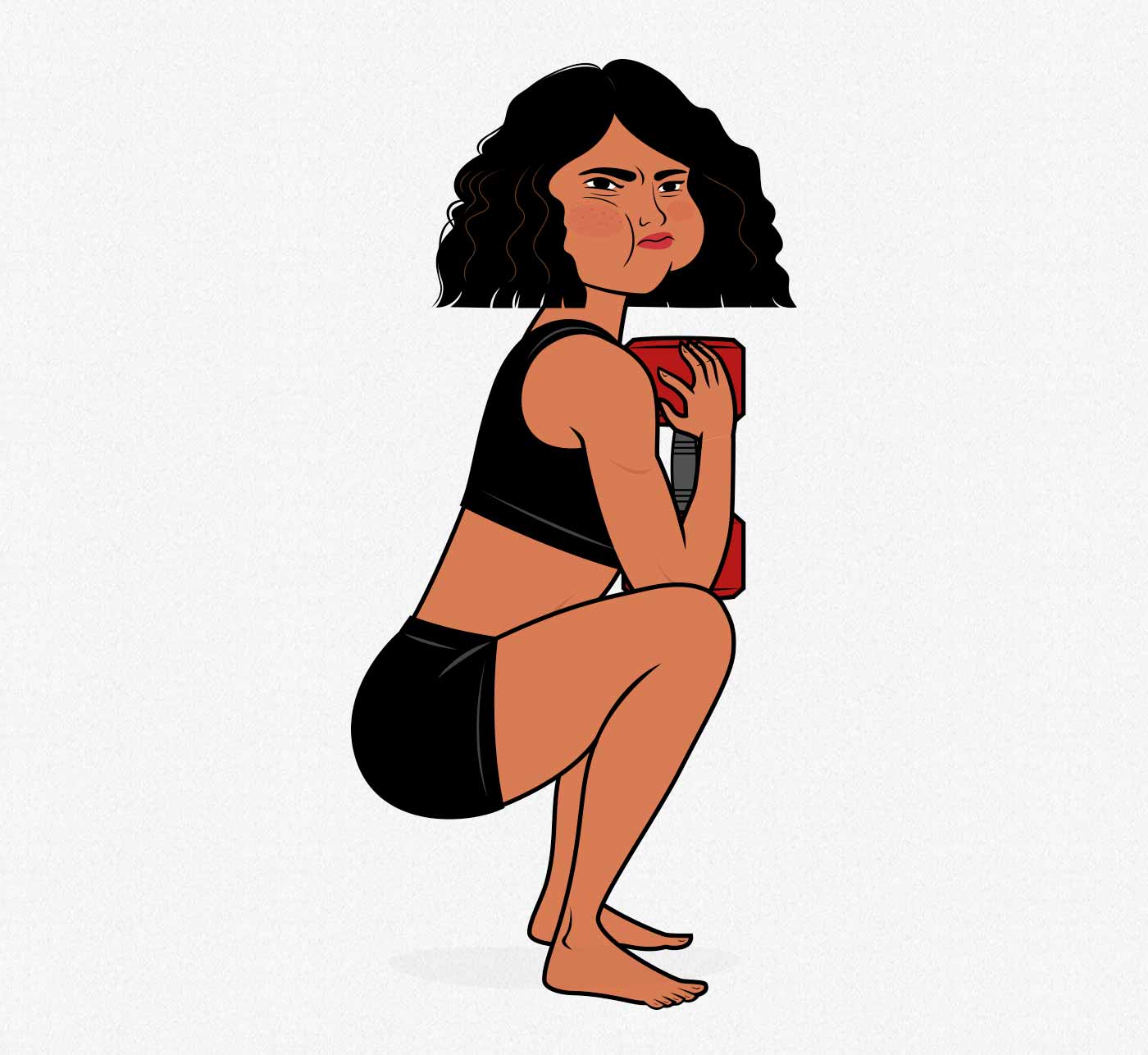
For example, goblet squats (above) have you holding the weight in front of your body, forcing you to keep a more upright torso, which makes it easier to get more bend in your knees. This makes squatting feel more natural and intuitive. And that’s good. It means you can push yourself harder sooner, stimulating more growth in your butt and thighs.
The “downside” of the goblet squat is that you have to hold the weight in front of you instead of resting it on your back. That demands more strength from your arms and core muscles. You’re working more total muscle mass. That’s good in the sense that you get more stimulus, but it’s harder.
It’s a brute strength exercise. It’s simple but difficult. And there’s nothing better for transforming your physique. If you could do just one exercise, this would be it.
But I recommend starting with at least four exercises:
- Goblet squats are an exercise for your glutes and quads, but it will also strengthen your core, straighten your posture, and build stronger arms. You can do them with a dumbbell, kettlebell, or weight plate.
- Romanian deadlifts are an exercise for your hamstrings and quads, rounding out your lower-body training. They also strengthen your lower back, your entire back, and your grip. You can do them with dumbbells or a barbell.
- Push-ups (or bench presses) work your chest, shoulders, triceps, and core muscles. They’re great for building upper-body strength and improving posture. Most people start with their hands raised on a counter or bench to make the exercise easier. The goal is to work your way down to the floor over the coming weeks and months.
- Rows (or pulldowns and chin-ups) work most of the muscles in your back, and they also work your biceps and grip. You can do them with dumbbells or a barbell.
Note that there are two exercises specifically for your glutes, which means your glutes will grow fast. You’re free to add extra glute exercises, but you don’t have to. The muscles that are being worked the least are your arm muscles.
Let’s go deeper into each exercise.
The Four Big Compound Exercises
Goblet Squats
Here’s Marco and Simone teaching the goblet squat. Don’t be discouraged if it takes you a little while to master. You don’t need to be perfect on your first day. Just strive for gradual improvement.
Notice how Simone lifts the weight smoothly and explosively. There’s no jerking, but she’s also lifting the weight quickly and with confidence, putting her full strength into it. Then, on the way down, she’s keeping the weight slow and under control.
Romanian and Dumbbell Sumo Deadlifts
Here’s Marco and Marielle teaching the dumbbell sumo deadlift, an even easier variation you could start with. It’s great for learning how to hinge at your hips, and it’s super safe and easy on your lower back.
Once the dumbbell sumo deadlift feels smooth, you can advance to the Romanian deadlift, using either dumbbells or a barbell. It’s another great beginner deadlift variation, and it’s arguably the best exercise for building bigger hips, stronger glutes, and better posture.
You don’t ever need to advance beyond Romanian deadlifts. You can keep loading these gradually heavier forever. But at some point, you might want to try conventional and sumo deadlifts. Those are even better for your glutes at the cost of being slightly worse for your hamstrings.
Raised and Regular Push-Ups
Here’s Mirielle teaching raised and regular push-ups. Whichever variation you’re doing, the important thing is to push hard, squeezing out reps until you can’t do another. And then next workout, try to do slightly more.
Once you’re able to do 20 push-ups on the floor—no small feat!—you can switch to the bench press if you want. The main advantage of the bench press over the push-up is that it’s easier to add a little bit of weight every week. The bench press is also easier on your abs and won’t feel quite as tiring.
If you want to stick with push-ups, you could just as easily switch to more advanced variations, such as the deficit push-up.
Rows, Pulldowns, and Chin-Ups
This is the dumbbell row. There are many different ways to row, and many of them are great, but this is one of the simplest variations to learn.
Once you get comfortable doing these rows, you can start practicing the lowered chin-up. And from there, you can transition to doing full chin-ups.
If you’re training at a full gym, another option is an underhand lat pulldown. It works similar muscles to the chin-up, but it’s a bit easier to learn. It makes for a good place to start, and it remains effective forever.
You’ll be doing some variation of row, chin-up, or pulldowns three times per week. You can pick your favourite and practice it until you master it. Or you can alternate between the different exercises.
The Workout Routine
The Workout
When you’re first learning how to lift, it helps to get a lot of practice. Doing every exercise three times per week is ideal for that. You’ll get good at lifting quickly. You’ll gain muscle and strength quickly, too.
Another advantage of spamming the best exercises is that it makes the workout plan incredibly efficient. You’re lugging out the biggest guns every single workout, stimulating a tremendous amount of growth.
Here’s the workout routine:
- Goblet squats: 2–4 sets of 10 repetitions.
- Dumbbell rows: 2–4 sets of 10 repetitions.
- Raised push-ups: 2–4 sets of as many reps as possible (AMRAP).
- Romanian deadlifts: 2–4 sets of 10 repetitions.
Don’t worry too much about getting exactly ten reps. Your muscles won’t mind if you fail at 6 or 15 reps. Six reps is slightly better for gaining maximal strength. 15 is a little better for improving your muscular endurance. Both are equally good for building muscle, gaining general strength, and improving your health.
It’s okay if you get 12 reps in your first set, 11 in your second, 9 in your third, and then barely manage 8 in your fourth. In fact, when you’re losing reps from set to set like that, that’s a good sign you’re pushing hard enough.
What matters is that you push yourself hard now, then try to lift a little bit more next week. You could lift a little bit more weight or try for extra repetitions. If your form felt off, you could try to lift with better technique. The important thing is to always try to outlift yourself.
I recommend downloading this free workout spreadsheet. It’s programmed into Google Sheets, which means you can open it in any internet browser or phone. The workout sheet lets you pick your exercise variations, tells you how long to rest, how many sets to do, and lets you fill in how much weight you’re lifting and how many reps you get.
GET THE GOOGLE SPREADSHEET OF THE
FREE BEGINNER’S FULL-BODY WORKOUT For Women
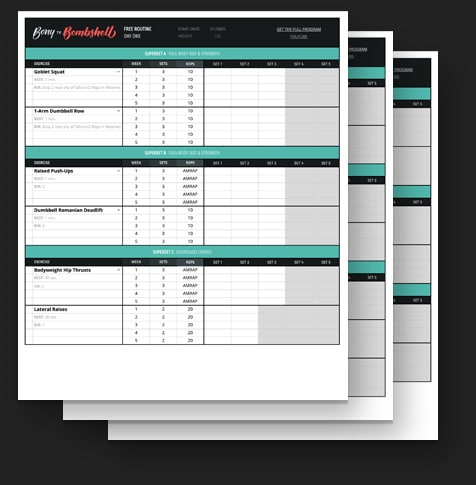
Get the workout as a Google spreadsheet. You’ll be able to pick from exercise alternatives, fill out the sheet, and get our beginner’s warm-up.
Plus, we’ll make sure you’re on the Bony to Bombshell newsletter, and send you all of our best women's muscle-building content.
Choosing the Right Weight
Everyone starts with a different amount of muscle and strength, so everyone will need to start with a different amount of weight.
The best way to find the right weight is to start much too light. Grab a weight you think you might be able to lift for thirty repetitions, but stop at ten. That will get some blood flowing and give you a bit of practice. You’ll get a feel for how strong you are, too. Then grab a heavier weight and do another ten reps. See how that feels.
Keep doing gradually heavier warm-up sets until you hit muscle failure at around 8–12 reps. That’s your first set. Write down how much weight you lifted and how many reps you got. Rest for two minutes, and then do your second set. Write down how many reps you got.
If you downloaded the workout sheet, you can write it in there. I like to write weight × reps, so if I’m lifting 80 pounds for 10 reps, I’ll write 80×10.
When you repeat the workout, look at your workout sheet to see how much weight you lifted and how many reps you got. Your goal is to lift a slightly heavier weight or get slightly more reps than last time. You might not be able to, but it’s important to try. Always write it down.
If I got 80×10 last week, this week I’m trying for 80×11 or 85×10. Either way, that would show progress. As a beginner, you should be able to gain strength fairly consistently from week to week.
Stop Just Shy of Failure
Failure is when you can no longer lift the weight with proper technique. If your postural muscles start to give out, you’ve hit failure. If you stop when that happens, lifting is very safe.
The dream is to learn how to stop right before you hit failure. As a beginner, though, you won’t know where failure is, so you’ll need to test it out. Try pushing yourself all the way until your muscles give out. Next time, try to stop right before that point.
As you get better at lifting weights, you’ll get better at knowing how many reps you have in reserve (RIR). You’ll notice when the weight starts to move more slowly. But for now, make sure you’re hitting failure often so you get some experience with what it feels like.
If it seems strange for a beginner to lift to failure, I’ve got a full article here.
Rest 2 Minutes Between Sets
It’s okay to rest longer if you need to. Whether you rest for two or ten minutes, you’ll still stimulate a similar amount of muscle growth. If two minutes isn’t enough, and you feel too tired (or nauseous) to exercise properly, feel free to rest for 3–5 minutes instead. There’s no rush.
The reason we recommend two minutes of rest is to keep your workouts short and dense. Your cardiorespiratory system will get a bit of stimulus, too, which is a healthy bonus. But if you need more rest or get interrupted partway through your workout, no problem. Just pick up where you left off.
If you want to blast through your workout even faster (and work your heart even harder), you can do the exercises as supersets:
- Do a set of push-ups
- Rest a minute
- Do a set of Romanian deadlifts
- Rest a minute
- Do your second set of push-ups
- Rest a minute
- Do your second set of Romanian deadlifts.
That way, you’re still giving your muscles plenty of time to recover between sets, but you’re doing another exercise during the rest period. This stimulates just as much growth as regular sets, and it’s slightly better for improving your fitness.
Start With Two Sets, Then Add More
When you first start lifting weights, your muscles will be very sensitive. It won’t take very much to stimulate tons of muscle growth, and doing too much can cause monstrous muscle soreness that can last upwards of a week. Having super sore muscles isn’t the worst thing, but it can interfere with your workouts, giving you more pains and less gains.
Your muscles will quickly get tougher, at which point they’ll be able to benefit and recover from doing more sets.
So, start with just two sets, then add more sets from week to week. I recommend doing two sets of each exercise in the first week. Practice your form, find the right weights, and take your time. Treat it like a practice day.
Next week, if you aren’t too sore at the start of each workout, try adding a set to each exercise. If that goes well and you feel ready for more, add a fourth set in the third week.
You can do as many as 6 sets per exercise, but 3–4 is usually the sweet spot. If you feel like you can handle more, then I recommend adding extra exercises instead. Hip thrusts are a good place to start, but you could also add split squats, lunges, farmer carries, biceps curls, triceps extensions, lateral raises, or whatever else you like.
If you ever start to feel worn down, or if you’re coming back after a long break, start the cycle over again, going back to just two sets per exercise.
Three Workouts Per Week
Each of these workouts will stimulate 2–4 days of muscle growth (article). You don’t need to wait until the soreness goes away before doing your next workout. That soreness should dissipate after a little warming up.
More important than how sore you are is how strong you are. You should be able to lift more weight or eke out more repetitions than last time. If you’re so sore that you can’t match your performance from the previous workout, you’re either doing too much or need an extra rest day.
Here’s a good default schedule, but feel free to adjust it:
- Monday: workout #1
- Tuesday: rest
- Wednesday: workout #2 (even if sore)
- Thursday: rest
- Friday: workout #3 (even if sore)
- Saturday: rest
- Sunday: rest (and full recovery)
Your muscles won’t fall off if you work out two days in a row. If your schedule doesn’t allow for a day of rest, it’s usually best to sandwich the workouts together instead of skipping them. The only downside is that your performance may be a bit worse in that second workout. You’ll still stimulate muscle growth just fine.
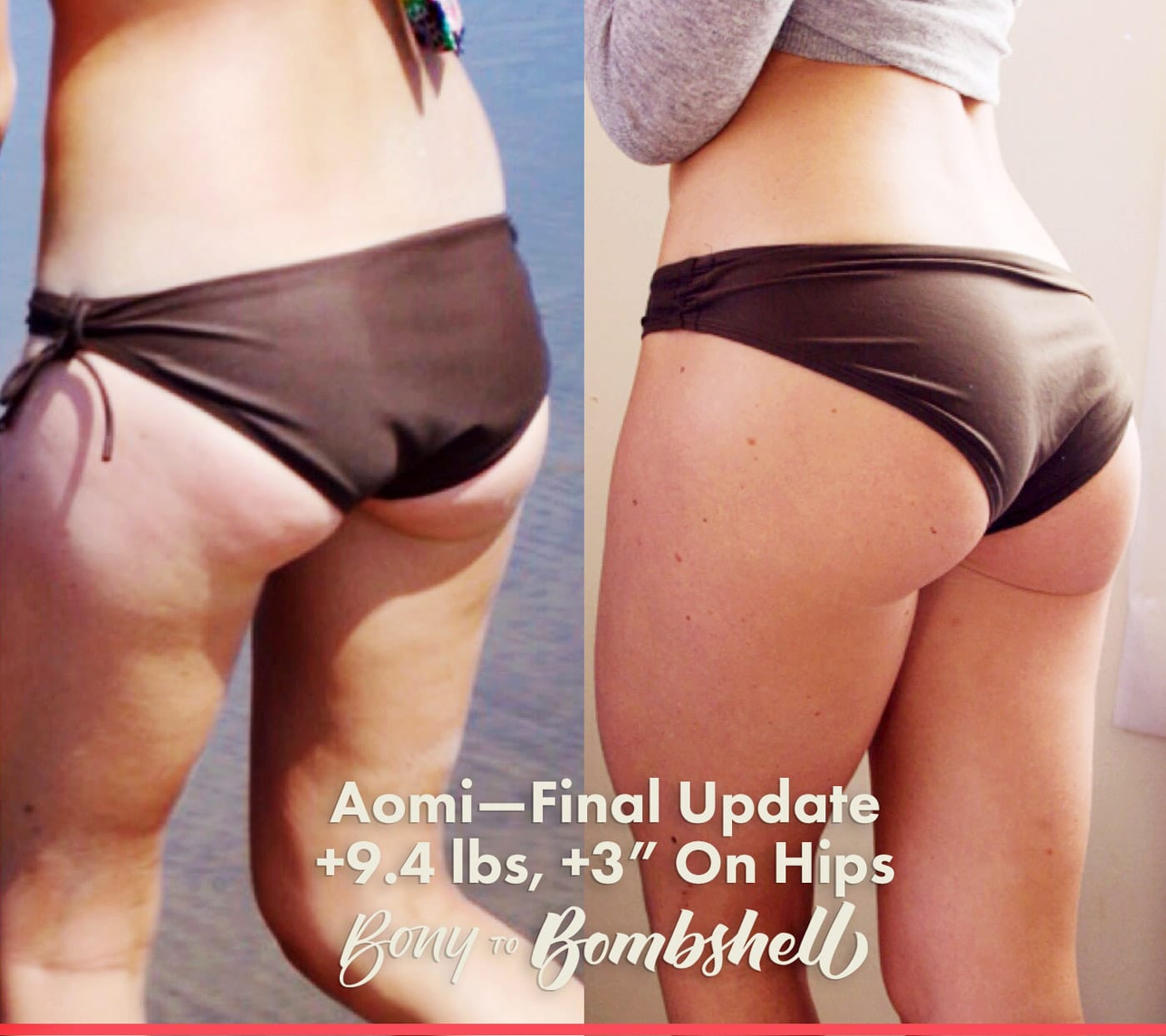
Add Isolation Lifts If You Want
This simple workout is a foundation you can build upon. You could add an arm circuit of biceps curls, triceps extensions, and lateral raises. Or you could do a core routine of planks and side planks. Or maybe 20 minutes on the elliptical.
Most women want to do extra glute exercises, which makes sense. You’re already doing squats and deadlifts, which is plenty, but adding in some extra hip thrusts or glute bridges to the end of your workout should help your glutes grow a little faster.
Barbell Glute Bridge (Barbell/Gym)
Bodyweight Single Leg Hip Thrust (at Home)
How to Support Muscle Growth
Working out is the best place to start. Worry about exercising before you worry about diet and recovery. But once you’ve done your first workout, it’s time to start eating for muscle growth.
When you’re ready, we have an article about how to eat for muscle growth.
After that, you can start tweaking other variables like getting into a good sleep routine, doing some cardio, or improving other aspects of your lifestyle.
GET THE GOOGLE SPREADSHEET OF THE
FREE BEGINNER’S FULL-BODY WORKOUT For Women

Get the workout as a Google spreadsheet. You’ll be able to pick from exercise alternatives, fill out the sheet, and get our beginner’s warm-up.
Plus, we’ll make sure you’re on the Bony to Bombshell newsletter, and send you all of our best women's muscle-building content.
What Next?
If you liked this article, you’d love our muscle-building newsletter. We’ll keep you up to date on all the latest muscle-building information for women.
If you want personal support from us, we have a full transformation program. We’ll walk you through the process of building muscle, including teaching you the lifts, giving you a full workout program, a complete diet guide, and a recipe book.
We’ll take a look at where you’re starting, set you up with a plan, help you track your progress, and give you feedback along the way. That’s how we can fully guarantee your results.

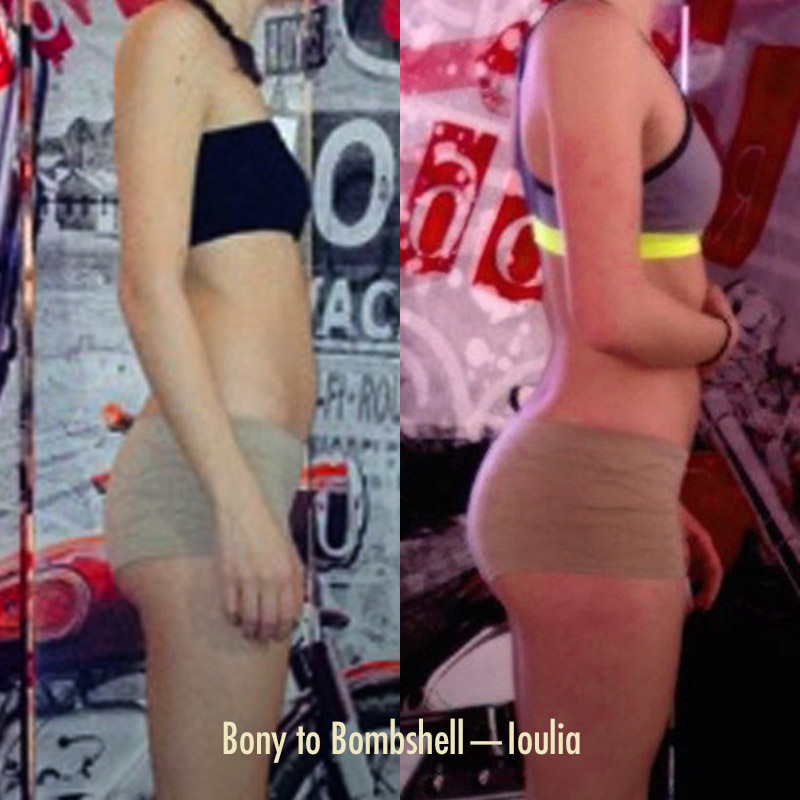
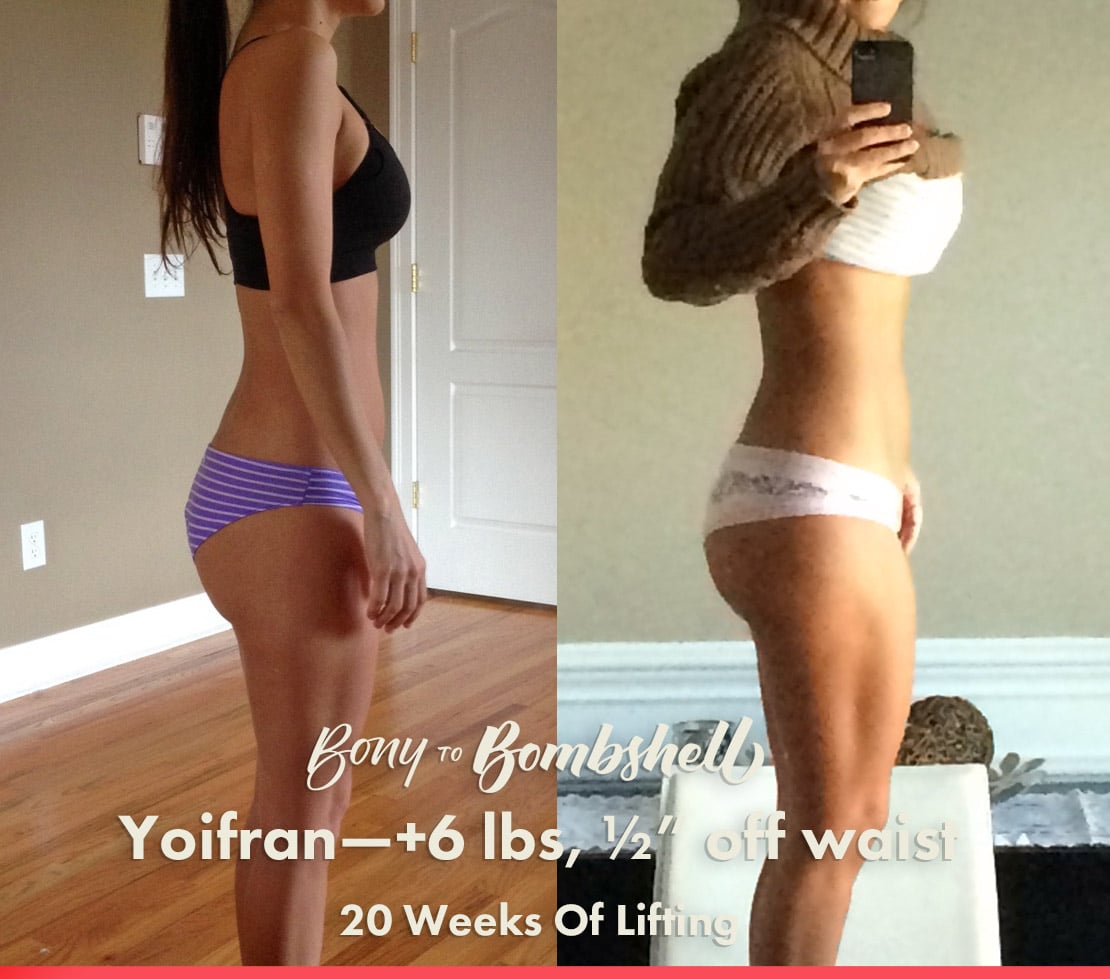
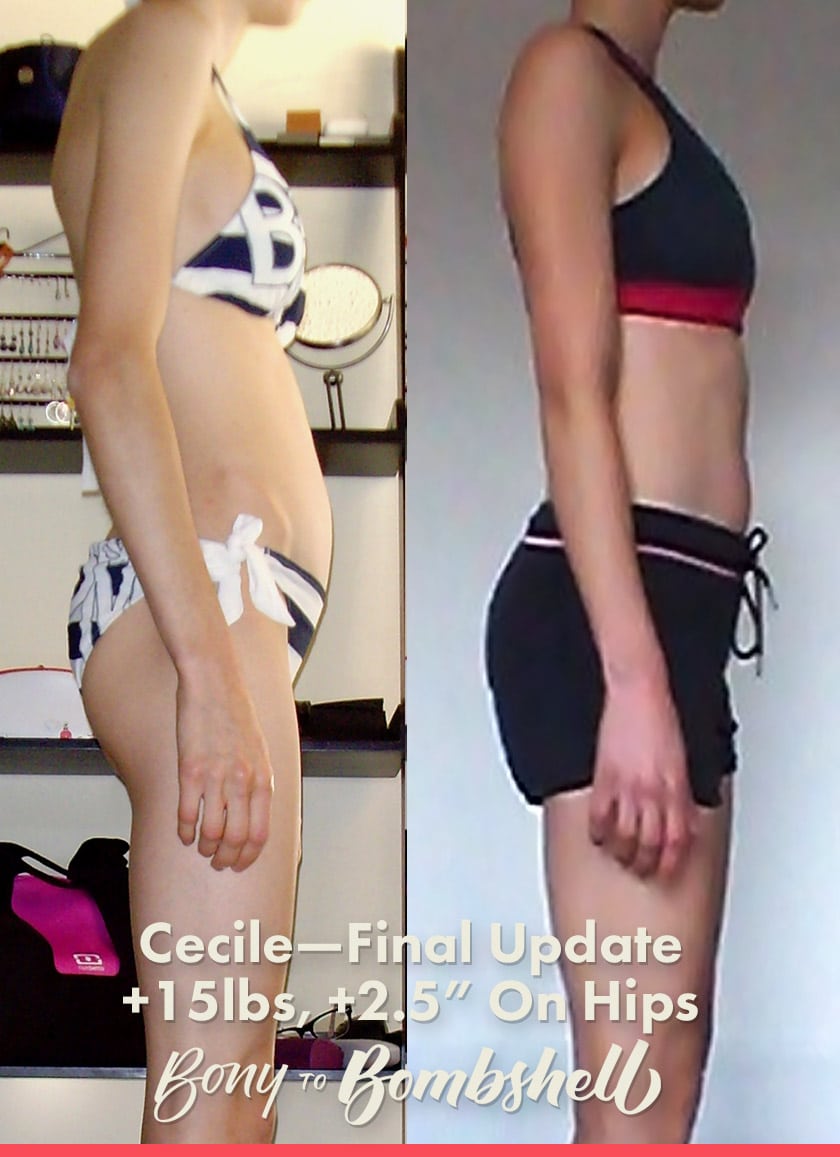

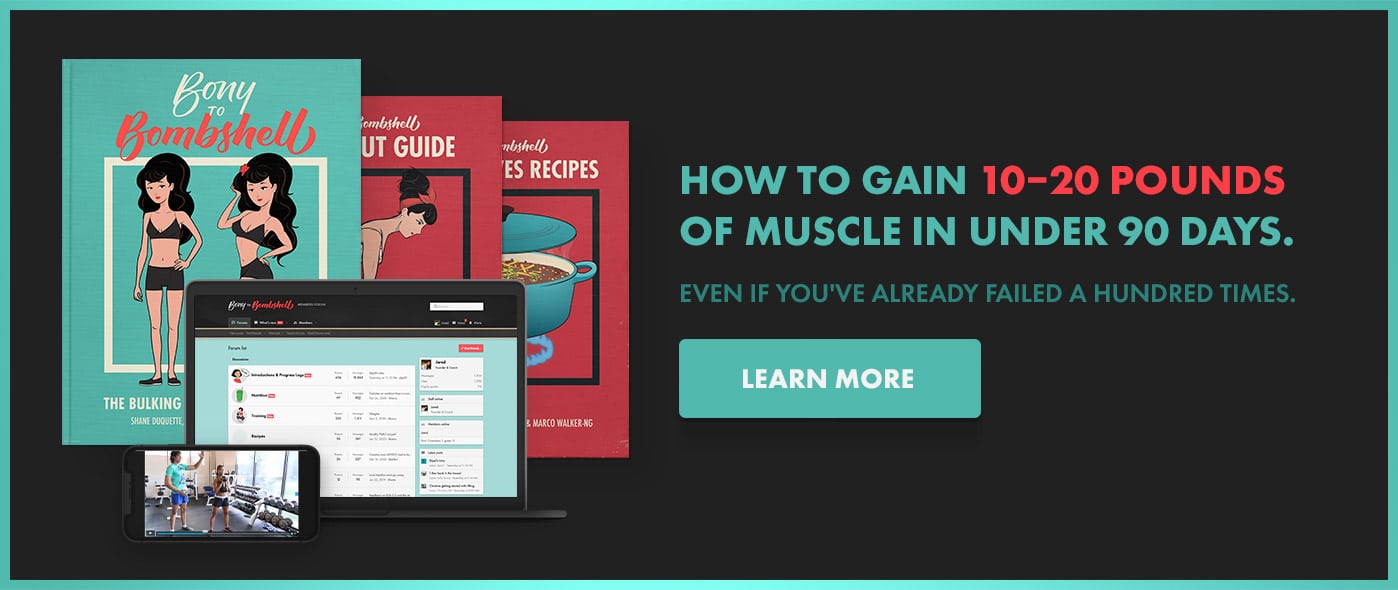
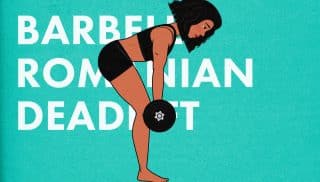
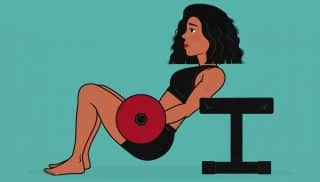
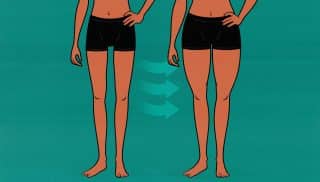
Ooh so excited for this free starter plan! Should be perfect to get me motivated since I’ve been putting off buying the full plan! Thank you so much Bony to Bombshell Team!
Really glad we could help, Bonnie! Good luck and let us know how it goes! 🙂
I’ve too have been putting off buying The Program.
I want to know if you can make progress using the information given on the website alone?
*I too/I’ve also
Of course you can, eat enough calories and protein..track it with an app;) and then do the routines.
Self motivate
Yes! Definitely. I did it for 3 weeks and saw great results and ended up buying the program.
I have been going at if for a year now. First time I ever stuck with any workout for this long and I feel and look great!
Can you recommend a good starting weight?
Hey Sarah, you’ll need to do some personal experimentation to find the right starting weight. Someone might be able to do 20 goblet squats while holding a 40 pound dumbbell when just starting, whereas another person may only be able to do 10 goblet squats while holding a 20 pound dumbbell. If I gave the average starting weight the stronger woman wouldn’t grow at all because the weights would be too light, and the weaker woman wouldn’t be able to finish her sets properly.
Start light and work your way up. The sets that are too easy count as warmup sets. The first “real” set is the one where you get almost to muscular failure—to the point where no matter how hard you tried you wouldn’t have been able to do another rep or two with proper technique.
Thank you so much!!! That helps!
There’s no way I can lift my boyfriend’s 20lb dumbell.
I can start at like, 5 or 8lbs & still see good results?
You might not be able to curl it yet, but you could probably do some goblet squats or dumbbell sumo deadlifts with it, and then it will quickly become too light for that.
But yes! So long as the weight is heavy enough that you can’t do more than, say, 20 reps before hitting muscular failure, then you’ll build muscle just fine even if it’s light in an absolute sense.
Hey Shane ! I am having some trouble
I am 21 years old and my weight is 103
I am having trouble gaining weight… I have recently started counting my calories to see if I can eat more than I burn off
however I find it soooo difficult to eat more than 1200-1400 a day
I get full so easy and on top of that I do not eat any meat(I have tried to, cant, and don’t plan on starting)
Do you know of any foods that are high in calories or shakes that are high in protein and calories? maybe if I find something high in calories then I will not have to eat as much
I struggled with this at first too! I started using the My Fitness Pal app to track what I was eating which helps a ton. There are TONS of great protein powders out there. Just experiment to find one you really like. I love using a hemp protein and make a shake of hemp protein, one frozen banana, powdered peanut butter and cacao powder and almond milk. Nutrient dense and great source of proteins! So I drink that after my work out and then mid morning also have a protein bar (I love Oatmega). Use nut butters (great source of calories, healthy fats and protein), avocados, and healthy fats. Once you start to track your foods you’ll be able to see where you can make easy adjustments to get the calories you really need!
I can totally relate to all of that. Eating enough is without a doubt the hardest part for almost all of us naturally thin people.
Sarah has you covered with the smoothie.
Some other good easy-gainers are:
Legume stews cooked in bulk (e.g. lentil stew or vegetarian chili)
Trail mix (add dark chocolate for bonus points)
Cottage cheese + strawberry jam
Muesli cereal + yoghurt or milk
Snacking is great, too. Adding in a handful of trail mix between meals and then maybe a protein powder shake after the gym—that’s often all that it takes 🙂
…(if you are doing this at home.) And thank you so much for your helpful articles!
Would it be wrong to use a kettle bell for the The Goblet Squat and The Dumbbell Sumo Deadlift?
I’m just starting out (still very bony lol) and there are two areas in my gym – the dumbbell area (which is really crowded for space) and the kettle bell area (not so crowded at all).
Kettle bells are great for those lifts, yeah 🙂
Hello! I am 17 years old, im 5’7 and i weight around 126. Im interested in gaining muscular mass and your program seems very effective. I have a little question, the models from the before and after pictures transformed their bodies by only doing those 3 excercises for several months? Are those the only excercises required? Thank you!
Hey Sonia, they aren’t models, just regular people doing the Bony to Bombshell program. They didn’t do just these three exercises, they did the full Bony to Bombshell program, which features many different assistance and isolation lifts, progresses you through several phases, etc. However, this would be a pretty perfect place to start 🙂
After you do this for a couple months, gain a few pounds of muscle… then you progress to the next stage.
When does the free nutrition article come out? Been stalking you guys for a while, figured I would get all my basics done before starting the full program. Super excited!
Glad you’ve been liking the free content, Davya! Soon 🙂 In a couple weeks, I hope. We might put out another mini-article first though.
I’ve done this three times in the past week. I already have a good diet that works well with my body, and already eat high-calorie nutritious food. At my heaviest when I was 13-14, I was 108lb. Now,nearly 18, I have been 103 at 5’7 for the past several years. I weighed myself this morning- 107! I really cannot believe this- it’s amazing. Is there a way to purchase the exercise portion of your program?
So glad to hear it’s working so well for you, Tuberose! 🙂
You can purchase the whole program here: http://bonytobombshell.com/weight-gain-program-for-women/
We aren’t selling the workout program separately, but we might come out with a smaller and cheaper version of the program (that doesn’t include the community or coaching) later, if there’s enough demand for it!
I hope that helps, and keep it up!
Hey Shane!~
So I’ve read your articles and been totally obsessed with your website. In reply to your comment here about releasing a smaller, cheaper version of the program, is that still in the works? I’ve been very unhealthy and underweight most of my life due to digestive issues and with medical bills and life in general I just can’t afford the full program. Unfortunately! Because I’m sure the value of your program exceeds the cost, based on the before and afters. I’m excited to try some things based on your articles as well but hoping I can get more out of a small version of the program. Thanks a lot!
Greetings!!
I’ve been struggling to gain weight and have a consistent diet to keep up with. I’m 23 weighing about 110 lb, my average weight before my weird weight loss was 130 lbs.. I would looove to get my curves back. I’m planning to start this weight out routine this week!!! However I’m worried about my diet, I do not eat meat, are there any foods/shakes/bars, etc.. Anyone can recommend to help me gain weight that are not meat ??
You don’t need meat at all. If you consume dairy that’ll be more than enough—milk, greek yoghurt and cottage cheese are all very rich in protein. Lots of carbs have a little protein in them as well—legumes, whole grains, nuts, peas, etc. And while eggs are mostly fat, they can be a good protein source too. Then there’s the muscle-building stable: whey protein. It can can be mixed with water, milk or blended up into smoothies.
If you want to avoid animal products altogether you can get some plant-based protein powder. They make it pretty easy to hit your daily protein targets even without meat, eggs or diary.
(We have some recipes for homemade protein bars and some simple higher protein vegetarian meals included with the program too!)
Hey, thank you for such a helpful article! I don’t have a gym membership but experimented with this for the first time today at home. I used a 5kg (11 pound) dumbbell that I already had in the house. I did 15 reps – it wasn’t easy but I wasn’t at the point of almost failure by the 15th. I’d like to buy a heavier kettle bell so I can do my first “real” set but was wondering what kind of weight to choose? I know it’s difficult as you haven’t seen me lift but any advice would be really appreciated 🙂
Hey Julia,
Getting a heavier weight will certainly help, especially if you get one with some growing room in it. Maybe if you got a 40–50 pounder, for example, at first you could do lower rep goblet squats, progress to higher rep ones over the course of a couple months, and then switch to lower rep single leg squats, then higher rep, etc.
However, it would be even better if you invested in some adjustable dumbbells. Those would grow with you, and they would allow you to combine together a bunch of different rep ranges and do a wider variety of lifts 🙂
Would love the program but the price is way out of my league:((((
Don’t worry, Mariz. We’re going to keep coming out with free content like this as well 🙂
This is awesome! I’ve just completed my first week and I feel amazing! Plus, I’ve gained 2 pounds! That never happens! Thankyou!
Yesss, congrats on the two pounds, Kelly Marie! 😀
Hi! I’ve been reading your blog and I am really interested in the program. I was just wondering if these exercises would be appropriate for someone with knee injury. I have a tear on my left meniscus (this is a very old injury) and I have always been wary of squats and the like. Do you know if the exercises are safe?
Thank you!
Yes, we can help you work around your injuries 🙂
(Coaching is included with the program, and Marco is well trained to deal with your particular issue.)
This is amazing I finally found something that made me feel better and excited about gaining weight…ppl usually look at me and say why do you even bother working out…but thanks so much I’ve been really wanting to gain muscle and weight. Going to try this.
Really glad we could help, Ramirez! Good luck 😀
Hello I’m 5 feet and weigh 91 pounds. all my life I have been little and its time to change… my question is how long before I start seeing results.. thank you
Hey Love, if you don’t see measurable results without your first week then it’s time to change something. For members of our program, for example, we recommend gaining around 0.3–0.5 pounds per week when the goal is building muscle. If they don’t gain that amount, we increase their calorie intake so that they grow the following week. How long until this creates noticeable, visual improvements? Usually 5–10 weeks, depending on their genetics and how consistently they follow the lifting and nutrition program 🙂
hello i would love to know if we need to warmp up before the excercises and if so what kind of warm up we need
That’s a really good question! The most basic warmup would be running through the exercises but with weights that are only about half as heavy to limber up and get some blood flowing. Dynamic warm-ups can work well in addition to that though. That might make for a good follow-up blog post 🙂
(In the meantime, just don’t stretch. It isn’t very good for increasing mobility/flexibility and it reduces strength for a little while afterwards, so you’d get a little bit less out of your workouts.)
Do you need to be a member of a gym to do this and do you need to buy a lot of equipment if you are at home?
Hi Myra,
You definitely don’t need to be going to a gym. Many of our members are working out from home 🙂 And the good news is that you don’t need a lot of equipment. You do however need heavy weights. We recommend getting two very heavy adjustable dumbbells (80-100 pounds each) and a bench. That will allow you to do every exercise you’ll need to do with heavy enough weights to be able to build muscle.
I hope that helps, and you can email us anytime if we can help clarify anything else 🙂
Hi, thanks for all the awesome info! I am 5’10” and 115 lbs, starting out at home with lifting. I did it for about a week as recommended in this article, but am finding that my lower back is really sore… is this normal for a bit when starting out with lifting because I don’t have much strength in my back yet? I do generally have a stiff/sore back (lower and upper), likely from poor posture and lack of muscles 🙂 I feel like my technique is good while lifting, but I don’t want to hurt my back.
Your lower back will be trained when lifting, we just want to make sure that you aren’t relying on it too much. Oftentimes soreness is caused by your hips being tilted forward, putting your lower back in a perma-flexed position. This can make it really tired and sore, especially when lifting.
Is the soreness in your spinal erectors? (The muscles running up alongside your spine.)
Its hard to say exactly. Possibly… it just feels sore in a general sense, I think. I will pay more attention to that and see if it makes a difference! Thanks!
I just found this program and boy, am i excited! I am about to turn 50, and i have been lifting weights since i was 18 and have only been able to put on minimal muscle. Now that I’m older, I’m turning skinny-fat! I would REALLY LOVE to put on as much muscle as i can and be a kick-ass 50 year old! Is this program for me, even tho I’ve recently gotten thicker in the middle? (Hint: PLEASE SAY YES!)
Oh no! The dreaded skinny-fat stage! Ahaha we see this happen in a lot of people as they get older. We can help you with that for sure. You’ll find other women in the community in similar places with similar goals too.
So the answer: YES! 😉
hello! I’m 20, 5’4 and 40kg.
I am student so kind of on a budget but I have a holiday to go to in August and was wondering if I use these weights my dad has at home which weighs 3kg will that work?
Hey Sana,
3kg is pretty light! Your muscles wouldn’t need to grow any stronger/bigger to use weights that are already light for you. I would recommend getting some heavier dumbbells (or getting your dad to get some). They aren’t that expensive, sometimes you can get them second-hand, and that would give you everything that you need to build muscle properly 🙂
Hi, Shane. Im Melissa and Im new in this workout stuff. Im skinny. I wanted some muscles. But im not a kind of girl that eats a lot. Any other suggestion for nutritions or workout tips for ads/muscles? If i workout 6 days a week, any chance that muscles will develop quickly for women?
Hey Melissa,
Working out six days per week won’t build muscle more quickly than working out just three times per week, but in either case, yes, women can build muscle very quickly! Women build muscle at a similar pace to men, actually, once you factor in their smaller overall sizes. Just make sure to do a program designed to build muscle, not a general fitness program.
You will need to eat more though! Learning how to eat more, more easily is a big part of the program, and we’re going to be writing more about how to do that here on the blog soon 🙂
My body can’t gain any weight..i mean i can’t get fat. Im weight abt 50 to 55kg.
And also, if i wanted to workout at home, any other stuff tht can use as weights other than buying dumbells?! I mean dumbells doesn’t come cheap in my hometown.
Ahaha it’s possible for you to get fat, just difficult. Once you figure out some appetite hacks and more about how to eat for weight gain, you’ll be in pretty good control of your weight. That means you could gain muscle or fat. I’d recommend building muscle, but you’d have the power to do either 😉
You could get a barbell and some weight plates instead, but that wouldn’t be quite as good for a beginner and that’d probably be more expensive. I’ve heard of people using dry-bags for camping. Those watertight bags designed to keep your stuff dry when canoeing and whatnot? You can fill them up with varying amounts of water so that each week you can lift heavier and heavier weights. Honestly though, it’d be worth spending an extra $20 and getting some actual adjustable dumbbells. If you order them online—Amazon or something—there are some cheap ones!
Like my friends said to me tht you must be fat so that the fat change to muscle when u workout. Is it possible for skinny people like me to have muscles? I mean..im skinny right?! So does that i can be more skinnier or its impossible cause i don’t have any fat to burn?
Muscle doesn’t turn into fat and fat doesn’t turn into muscle. They’re totally separate things.
A skinny person can build muscle. A skinny person can also lose fat, but if you already have a low body fat percentage, it will probably make you look and feel a lot better if you focus on building muscle instead.
Hi! Just learned about your program and trying to figure out if it would work for me. I’m pretty much thin all over but store fat in my belly 🙁 I’m 5’2″ and weight 114 lbs. I do have some fat I need to loose around my belly. Should I loose this fat before I can start this program to gain more curves in other areas of my body or will this program help me loose the belly fat and gain muscle weight as I do it? I know the program is intended to gain weight and I definitely need that around my legs and booty but I need to loose my belly. I’m afraid of starting the program and gain more weight in my belly due to the high calorie intake. Please let me know your thoughts. Thank you!
Hey Nina,
If your goal is maintain/build muscle mass as you lose the fat, and it sounds like it is, then I’d recommend starting up a program like this one before you lose any weight. Otherwise some of the weight you lose will be fat, some will be muscle. (Your calorie intake would be specific to you and your goals.)
And yes, we have fat loss guides included with the program as well, although always with muscle and strength in mind 🙂
Hi! Just learned about your program. I’m 23 and weigh 43Kgs, I’ve been trying to put on weight but nothing really helps. I have started to take care of my diet and also started working out. Could you please help me with some lower body work out?? I have skinny legs and nothing fits me well!:( And also if you could tell me how many mintues of work out is helpful.
Hey Neha, this beginner’s workout should help get you started. For a more thorough, optimized routine that includes coaching and customization, I’d check out our full Bony to Bombshell Program.
How long your workout takes doesn’t matter much, but 45–75 minutes 2–4 times per week is often about right.
HI I’m Stace I’m 16 and I need help to make my body look more attractive and yeah sexy .haha.im trying my best to be fit .i eat a lot I exercise but it seems like it’s not enough.
Hey Stacy, did you read our other post about nutrition?
http://bonytobombshell.com/beginners-nutrition-guide-for-women-looking-to-build-muscle-gain-weight/
If you’re doing a good lifting workout a few times per week and eating enough calories to gain weight, eating enough protein to build muscle, then that should at least get the scale moving in the right direction. Based on how you progress in terms of strength in the gym + bodyweight on the scale, you can then adjust things as needed to keep moving forward.
If you want coaching through this whole process along with a more comprehensive guide (and tons of strategies to make things easier), we have the Bony to Bombshell Program as well:
http://bonytobombshell.com/weight-gain-program-for-women/
I really hope that helps!
Hi do you have pre-beginner tips. I can’t do even one push up. And barely able to do 15 squats without holding a weight.
Hey H,
Did you watch the full push-up video? Most people will need to start with a raised push-up to make it easy enough, and that’s perfect fine 🙂 That’s actually good news as far as muscle growth goes too because you have a long time before you’ll become so strong that push-ups won’t build muscle anymore. (Once you can do 30+ push-ups from the floor, they’ll cause you to improve your endurance instead of your muscle strength / size.)
Same thing with squats. Right now you’re in the ideal muscle-building rep range, so no issue whatsoever. Start with a range of motion you can do properly, and gradually work your reps higher. When you can do 20 or even 30 reps, start loading it up with weight to get you down in that under-15 range.
The workout will still feel awkward for a couple weeks, but that’s not because it’s too difficult, it’s just because you’re moving your body in new ways—like trying to brush your teeth with your left hand. Feels weird at first, but you’re more than capable of doing it with a little practice 🙂
Hi, My names Taylor I’m 19 and weigh 89lb and a girl. I’m very underweight and have been that way since like 15. I eat a ton of food per day, I eat small snacks but about 6 times a day and I’ve tried just eating large meals 3 times a day and nothing seems to work. I really hope this helps put on weight. I have a pretty small chest.. Will the push ups make it smaller or will that help with growth as well?
Hey Taylor,
Eating more frequently (or snacking between meals) will often work well when trying to gain weight, especially for us naturally thin people who have smaller stomach capacities. Nothing wrong with eating three, four, five or six meals, so just pick the schedule that allows you to consume enough calories 🙂
Making a muscle stronger will always make it bigger (provided you eat enough calories to gain weight, and enough protein to build muscle). This is true for your chest, which will become bigger by doing push-ups, and even your abs! The more crunches you do, the bigger your waist will become. For some this is good, for others not so much. In your case though, with your chest, yes, push-ups are a good way to grow it 🙂
Hi, I’m trying out this routine and I got some adjustable dumb bells, but the disks are much wider and when stacked are thicker than what’s used on the video so I can’t hold the same way – is it ok to hold by the bar one hand above the other? Or would it be better to get a kettlebell for that one?
I’ve got those dumbbells too. I know what you mean. Holding it however works best is okay, just switch up which hand is on top from set to set so that you develop your muscles in a symmetrical way. Also be careful! The most common lifting injury is dropping a weight on your foot 😉
Hello! How much is the program? Do you have any promotions going on?
Hey C,
The program is 197, and it includes the main eBook that teaches you everything you need to know about muscle-building nutrition (including how to comfortably eat enough to gain weight), everything you need to know about lifting, supplements, and everything else. It also includes a 5-month workout program and videos teaching all of the lifts. Perhaps most importantly, it includes a yearlong membership in the community + coaching from us along the way to make sure you can overcome every obstacle 🙂
http://bonytobombshell.com/weight-gain-program-for-women/
For promotions, we could set you up with a payment plan. If you’re a student, we also have a student discount. Send us an email at us@bonytobombshell.com for the details on those 🙂
I’ve alrdy brought some protein shake powder. Hw often should i drink it? I mean i’ve workout only in the evening and should i only drink during workout? Cuz i’ve read some other wedsite abt it, and said i should drink it before bed, after i wake up, and 30 minutes before starting workout. And also, if i didn’t mix anything but the protein shake powder, it still works on growth or should i really mix with vegetable, fruit and etc to make it work?
You can have the protein shake whenever you aren’t hitting your protein goals with whole foods. So if you aren’t going to get a gram of protein per pound bodyweight that day, add in some protein powder. If you realize that right before bed, have it right before bed. If you already know you’re going to have a low protein day in the morning, have some when you wake up.
You can also have a scoop of protein powder after working out.
You don’t need to mix it with anything, but you can!
Hi, i am 21 and i don’t have any hips at all and i have a larger upper body and thin legs. I measure 32-26-34. Is there any workout i can do to balance out my body and gain some hip muscle. And also for weight lifting, do you think 10kg dumbells are good enough to build a bigger lower body for me or do i need heavier dumbells and also what exercises do i need to trim my upper body? Thanks.
A workout like this one would be a good place to start. Our Bony to Bombshell program would be even better. We have all the isolation and lower body emphasis lifts in there, along with videos teaching you how to get the most out of them. It includes everything you need to know about nutrition as well, a membership in the community, and coaching from us throughout and 🙂
You can do some stuff with 10kg dumbbells. You could do even more with 20kg dumbbells. And even more with 40kg dumbbells.
Generally, the lower body needs heavier weights than the upper body. Women can usually build a much heavier squat than bench press, for example. This is even more true with the lower body isolation lifts, like the glute bridge and hip thrust. Mind you, in a pinch, you can get some good results by focusing on single-leg stuff with lighter weights. You can do a one-legged hip thrust with lighter weights than a regular hip thrust, and you can do a split squat or lunge with much lighter weights than you would need for a goblet squat.
To trim up your upper body, the main thing you’d want to do is lose a little body fat. This is best done by losing weight overall. Given your goals, though, that might not be something you want to focus on right now. Fortunately, those who are new to weightlifting can often lose some fat and build some muscle at the same time if their nutrition and lifting programs are good enough.
You can also get some visual improvements in your upper body just by following a good lifting routine. A good lifting routine will include some upper body compound lifts, and those will help you tone up your upper body by adding some muscle mass 🙂
Hi, I live in newzealand and have tried contacting you via email, I would really love to start this program but, would like to now how the format works, do I need a laptop or is it a book? I have a few other question, thanks Melissa
Hey Melissa. We answered your question via email, but for the sake of anyone else reading, the book is digital, so you can read it on your laptop, desktop, tablet, smartphone, or however you like 🙂
Hi! My name is Samantha, I’m 17 years old, around 5’0″ and 118lbs. I’ve been very insecure with my body for such a long time now, since my freshman year of high school. It really upsets me that although people in my school are alarmed when I tell them I weigh as much as I do, that I’m still considered “small and skinny”. I have no problem being short, I’m just very unhappy with my body. I wear a size 00 in jeans right now, just about everything that I wear is a size XS/S. I’ve been wanting to change my body for a long time now but I’m unsure of how to start. My goal is to try to go up a few jean sizes, like instead of being a 00/0 I would like to be a size 3. I’m also very fond of a body shape that I’m not exactly sure if I have. My ultimate goal is to have a larger/wider bottom portion than my top half- pear shaped. My measurements are 34-29-37. All I honestly want for myself is to be a little bit thicker, with thicker thighs and wider hips. I’m so in love with the idea of being this way that I’m very sad with myself. It just really depresses me being called skinny, knowing that I barely have “anything” to my body. And I know this may sound ridiculous, but this has affected me so much that if I can’t achieve the body I want on my own I would perhaps resort to surgery in the future, if such a thing is possible. I would really love to hear your input and advice, and if this is something that is truthfully attainable for me. I have profile images if that would help. Thank you for taking the time to read this, it means a lot.
Hey Samantha, I think the news here is pretty good. Your lower body, especially your hips, and thighs, are covered in muscles that all have a great deal of growth potential. So your ability to get the shape you want should be fairly achievable if you’re willing to lift some weights, diet right, gain some weight, and rest like a bear. (Note: Hips will get deeper more so than wider, but some width will be gained as well!)
Perhaps better still, you can definitely, definitely, 100% get strong and curvy enough that no one will ever think of you as skinny ever again. And you can do it in a very healthy, natural way that will cost a fraction of what surgery would cost 🙂
You might think that it sounds ridiculous given how few people you know who are struggling with the same thing, but as someone naturally skinny who deals pretty much exclusively with other naturally skinny people… I couldn’t relate more. Even drastic measures like surgery didn’t sound so unreasonable for me. That is, until I realized I didn’t have to do that (and that surgery wouldn’t look/feel/be nearly as good as doing it with lifting/diet.)
I really hope you decide to join our program! You sound like exactly who we wrote it for. But even if you don’t, you’ve already stumbled on a great way to get started 🙂
Hi My name’s Rach in 24. I was a dancer for about 15 years ,lots of ballet etc however i have stopped dancing about 3 years ago, and therefore stopped training. I am 5ft 5 inches tall and weigh 46kgs. My biggest issue is that my abs are muscular but they stick out rather than being flat (I have no boobs so this makes it look worse). I think this may be due to years of incorrect technique for sit-ups etc. Could you recommend the best way to correct this? Thanks so much in advance 🙂
xx
Hey Rachel, it sounds like your hips are tilted forward, making your stomach stick out. There isn’t a super easy fix for this, but it’s very common, and a well-rounded approach to training will gradually get your hips back into a more neutral position. The general workout advice here should help, but it’s important that you do the exercises with great technique so that you get all the benefits. If you’re doing everything with your hips tilted forward, it won’t do much to fix them.
There are some exercises, like planks, which teach you how to hold a neutral position, but you’ll also want to use loaded exercises, like deadlifts and goblet squats, that will strengthen that position.
You know what, this merits an article of its own. I bet Marco would like to write that article, too.
(Also worth pointing out that in the meantime, the Bony to Bombshell program fully covers all of this, with tutorial videos explaining exactly how to lift with your hips in a neutral position so that they’ll stay that way naturally in your day-to-day life.)
Hi, my name is Mystical Allen. I’m only 18 years old but I’ve been struggling to gain weight for a while. I eat a ton but I can never gain extra weight, I’ve been 119 lbs and 5’8″ since I was 13 years old. I tried working out, I’ve bought pills, and I also purchased an online workout regimen similar to yours but I still saw little to no results. I’m really skeptical about purchasing anything new because of my past experience, but I still wanted to know if you thought there was any hope for me.
Of course there’s hope! At 18 I was in the same bony boat as you, with lots of failed attempts under my belt. I was 125 pounds at 6’2. That’s why we made this program. To help people struggling with that same issue of not being able to gain weight no matter what they try.
I get the skepticism for sure. I would think the same thing. Would it help to know that we have a full refund policy? You don’t need to wonder if it will work, you can try it. If you don’t dig it, you send us an email and you get a full refund.
Fortunately, you’ll get into the community and realize that other people struggling with the exact same thing as you are are succeeding, and I think you’ll find the confidence to trust us for long enough to get you results. After you first week alone, you should be up 0.5–1 pound, and then you’ve just got to keep at it 🙂
Hi there, im so excited that i found this site! Im 20 yrs old, 5’1”, and only 95 lbs. Ive been slowly losing weight as i get older & tired of it! Ive began drinking protein shakes that add an extra 1300 calories per day to my meals. I dont substitute meals for shakes, i always eat with them. I use 2 10lb dumbells. What advice can you give me to improve? I want to start the program. Are the shakes going to help? Thanks!
Shakes are definitely going to help. Getting some heavier adjustable dumbbells (or a gym membership) would also help. After all, building muscle is about getting real strong, and to do that, you’ll need some heavy things to lift 🙂
First thank you for the free guide. So excited because I have to wait until July before I can look into buying this program.
I am curious about whether I matters how we do our push ups. Do we really need to do it on a bench or does a regular floor position or kbee to floor position count as fine? I don’t get close to 15 reps for push ups 5-7 doing regular and about 10 on knees.
As long as they are proper and not stressed should I just do extra sets in a work out or just stick with 2 for the first week ?
The bench or raisded push-up is better than the knee position on the floor.
It’s good to remember that you don’t need to annihilate your muscles, just stress them enough. So it sounds like from the floor is just a little bit too tough for right now. So try them off the bench and in a week or two you might be back down to the floor but stronger than ever 🙂
Hi im monica and iam 17 years old , i wanted to know how to get a more curves amd a bigger butt by weight training but iam skinny all over except for my stomach which is the place i store fat and gain weight the most in …..how much calories a day should i eat?….should i eat more calories than i burn to gain weight or eat less calories that i burn to lose weight ? And also i eat 1000 calories a day but it only contains junk food or white rice,etc.
Hey Monica,
Being under 18 you should always talk to your doctor or parents first before beginning *any* lifting or nutrition program.
We don’t know exactly how much bodyfat you’re carrying, some people that say they’re fat are extremely lean and vice versa. But generally it’s best to focus on one goal at a time. Either burning fat or building muscle. Check out the beginner’s nutrition guide on this site for a bit more info on calories.
This sounds amazing and I want to try but I have to wait until I can cancel my gym membership in November so I can afford it. I have been working out for years. I played sports all through high school. I had 2 kids the past 2 1/2 years and after both kids I lost so much weight so fast. I was worried so I had my thyroid checked but it was fine. I am 5’1 or 5’2 and had always weighed around 100lbs through high school and after (103 being my heaviest and 98 being my lightest) I had gotten sick with bronchitis and had stress from two kids and being in a wedding and remodeling a house this past December and got down to 93 lbs!!! I immediately went to get a gym membership and a personal traniner. She helped me gain muscle and got me back up to 98-103 lbs (varies by the day /time of the day) but she moved out of state so now I am at a stand still with my weight being 99-101. I have always eaten a lot and any foods that I want however I tend to eat a lot of fruits and veggies just because I like them. Also a lot of sweets. I love meat too I just don’t know how to cook it / have time to cook it since I work and have 2 young kids. I am definately interested in starting this program. I was thinking in the meantime I would start with the first couple week work out plan that you had in a video on your page. I deff need to get my chest and shoulders bigger. They are so bony!!! So annoying and annoyed with people saying how small I am, I don’t want to be so small !
November isn’t so far away 🙂
Agh, the sounds like a really stressful time. Being a busy mother with bronchitis living in a house undergoing renovations while being in a wedding sounds crazy. Crazy how our body type responds by losing weight, whereas the average person will gain a few pounds.
If it helps, we’ve just, just released a brand new version of the entire program, and along with the new release, we’ve included the option to pay with a payment plan:
https://bonytobombshell.com/weight-gain-program-for-women/
It includes a recipes that should help you with the cooking / appetite side of things, too 🙂
#biggertomorrow
[…] grams of protein, which is ideal in most cases, but when you train your entire body each workout, as we do, we’re stimulating an unusually large number of muscles all at once, so we benefit from a […]
I know its 2018 and it’s been a long time this article was written but if anyone see my comment can you help me please? First of all sorry for bad english (it’s not my first language).
Here are my questions:
-The workout in the video is the only work out we do all along the week or do I need other exercices?
-My arms are so weak I can’t do even 2 push ups what sould I do?
-The weight I can “grab” is very light I see some people grab 30kg I can’t do that. Is their a specific weight to grab if I want to gain weight?
Thank you if someone can answer me.By the way article is very cool and helped me understand some things I was wondering about.
Hi Jennifer! Is your goal to gain muscle in all areas? In my personal opinion, you target a different muscle group each day. I started lifting in August of 2017 & my weight went from 95lbs to 108lbs since then 🙂 I dont do cardio, i just lift HEAVY & stay consistent. 5 days a week & rest on weekends. I hope this helps!
What foods would you recommend eating to help gain weight?
I’ve been using the resources you have available online for 2 1/2 weeks now and my boyfriend has already noticed a difference. Can’t wait to keep it up!
On rest days, can you do a form of cardio or would that hurt building muscle? If so, how much should I do and intensity? Also, how long should the beginner workout be done for on those days? 30 minutes? 60?
Hi! I have been able to gain weight and get to my desired number on the scale. However, now I am really confused how I can just maintain this weight, not lose or gain any now. If i stick to my skinny days diet and workout plan, i would only get back to skinny. And if i keep on doing the workouts and eating enough calories as during the weight gain journey, I will keep putting on weight. Any suggestions? Thanks!
OMG- LOVE LOVE LOVE THIS- thank you. I am a squat pushup girl, but need to up my game. Want to be able to do it at home. SO many of the workouts for strength are overwhelming, even when they say ‘beginner’. This is so do-able and I never even thought about adding weight in those two positions to the squats (you don’t know what you don’t know). I’m kind of a bony girl in some ways, but have the dreaded weight around the middle- cannot diet away anymore and need to build muscle. Want a TON more weight/bulk in my legs and arms, more in my butt is fine, and also want more strength in my core. Why are we not talking about this more, as women who are looking to lose or gain ‘weight’? Anyway, thank you, thank you, and I can’t wait to get moving (like literally going to do it now). I’ll be back!
Woot! Good luck 😀
i heard you need to do 3 exercises per muscle group to see real results. i don’t see each muscle group worked here and i don’t see 3 for each muscle group. can you explain why you still expect to see results with this routine, results like 10 lbs muscle gain in first year for an average woman as you describe? thanks!